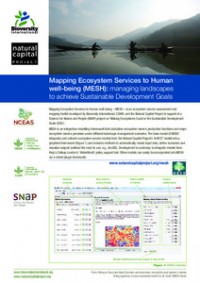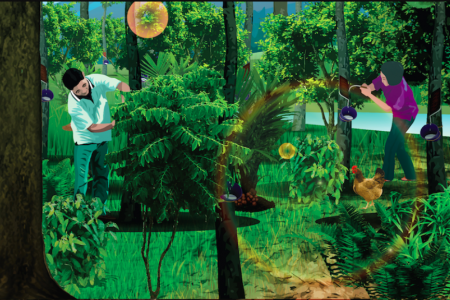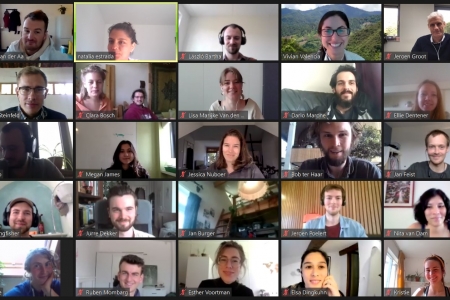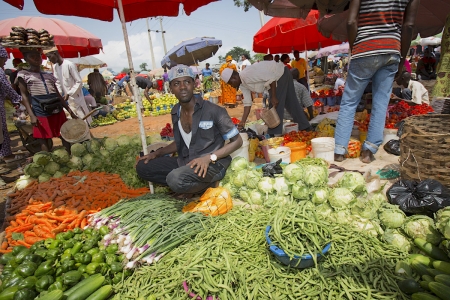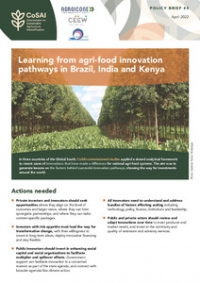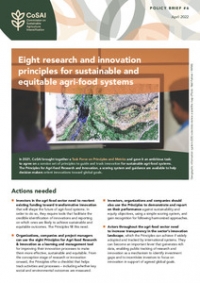Deep into the annual talks at the 8th Ecosystem Services Partnership conference held in South Africa’s mega diverse Western Cape, Bioversity International and Natural Capital Project colleagues filled the room with attendees hungry to learn more about MESH, the Mapping Ecosystem Services to Human Well-Being tool. Although it is still at an early stage, this clever tool has plenty of fans and a wide variety of uses for policy makers, scientific advisors and ecosystem services specialists.
So what is MESH about? As its name indicates, it is a free, downloadable software tool that ‘meshes together’ maps of ecosystem services from already existing tools (such as Natural Capital Project’s InVEST and King’s College of London’s WaterWorld) into a user-friendly interface that enables users to rapidly analyze how a policy or investment decision may impact ecosystem services such as food production, erosion or carbon sequestration.
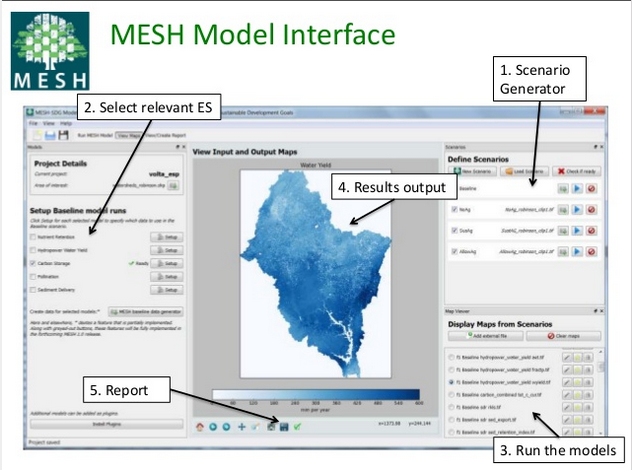
Bioversity International and Natural Capital Project teams are currently using MESH to evaluate how different approaches to managing river and stream banks (known as riparian buffers) might impact ecosystem services in the Volta basin. This work is part of the CGIAR Research Program on Water, Land and Ecosystems ‘Targeting Agricultural Innovations’ project. The teams aim to support the Volta Basin Authority and its six member countries to prioritize and target ecosystem-based activities required to achieve water quality targets set out in their strategic action plan.
The next stage of MESH will link changes in ecosystem services to indicators of human well-being in the context of the newly launched Sustainable Development Goals (SDGs).
From the Volta basin to SDGs: A changing policy context
The SDGs set ambitious global targets for poverty alleviation, food and water security to 2030 and call for a shift towards sustainable production and consumption systems. This is an integrative agenda that calls for integrative tools and approaches.
“This is a huge opportunity for ecosystem service research to contribute to development. If we can show how accounting for ecosystem services contributes to achieving these global goals, it will make for a very strong argument for leveraging ecosystem services to achieve development across a number of different sectors,” said Dr. Sylvia Wood, post doctoral fellow at Bioversity International and Columbia University’s Earth Institute.
When well-planned and managed, natural resources and their ecosystem services play an important role in supporting agricultural systems and the livelihoods of the poor. However, Sylvia Wood and Sarah Jones stressed during their presentation, these contributions often remain unquantified and poorly linked to measures of well-being, leading them to be discounted during decision making. Finding ways to map, quantify and visualize trade-offs between the contributions of natural resources and ecosystem services to the attainment of SDGs is critical if we wish for them to be included in planning processes.
Seeing the need for a tool that can link shifts in the landscape to metrics of ecosystem-driven changes in human well-being, Bioversity International, The Natural Capital Project and project partners created MESH, as part of a Bioversity International-led Science for Nature and People project.
This new software, firstly, brings multiple ecosystem service models into a common platform for a more integrative and rapid approach to multi-service trade-off analysis - a huge boon for researchers and policy makers bogged down in technical challenges of managing the complexity of today’s global challenges: food security, environmental sustainability, and poverty reduction.
Secondly, MESH provides narrative outputs to help users understand how changes in ecosystem service provision contribute to stated SDG goals and targets. Once the official SDGs indicators are agreed upon in 2016, the second release of MESH will link ecosystem service outputs against these metrics.
Maps that tell a story aid decision makers
“Before we started any work on MESH, we held interviews with stakeholders in the Nile and Volta river basins to understand policy maker and investor interest in and need for using SDG-relevant tools. This led us to focus on links between ecosystem services and a small number of SDG-related indicators that stakeholders highlighted could provide important information for decision making,” explained Sarah Jones, research assistant and PhD student at Bioversity International and King’s College London.
Freely available global datasets are embedded into the MESH model interface to facilitate rapid global analyses and analyses in data poor areas.
“MESH assists you in generating scenarios – creating living maps that tell a story – while simultaneously calculating multiple ecosystem service metrics across a landscape and visualizing results inside the tool’s interface,” said Natural Capital Project’s economist, Dr. Justin Johnson.
As MESH is further developed, it will expand the range of ecosystem services assessed and their links to SDG indicators, and it will allow its users to bring maps to life by visualizing the link between SDGs and the benefits that ecosystem services can contribute to human well-being, such as access to clean water, risk of malnourishment or exposure to malaria.
“MESH brings together some of the “greatest hits” of ecosystem service models and spatial analysis tools to let policy makers more quickly assess how ecosystem services might affect their attainment of the SDGs. We hope MESH will better inform policy to protect ecosystem services and their vital link to human well-being,” said Justin Johnson.
Learn more and download MESH
